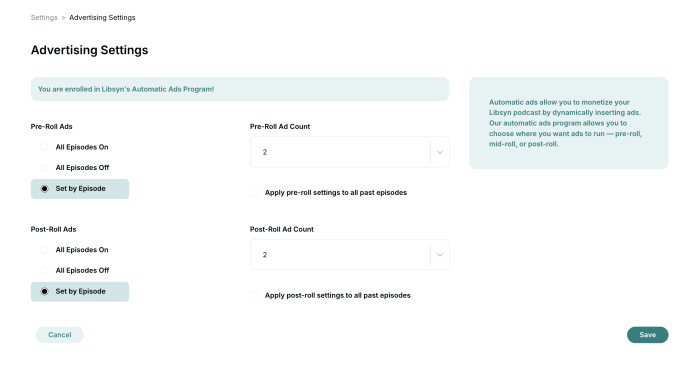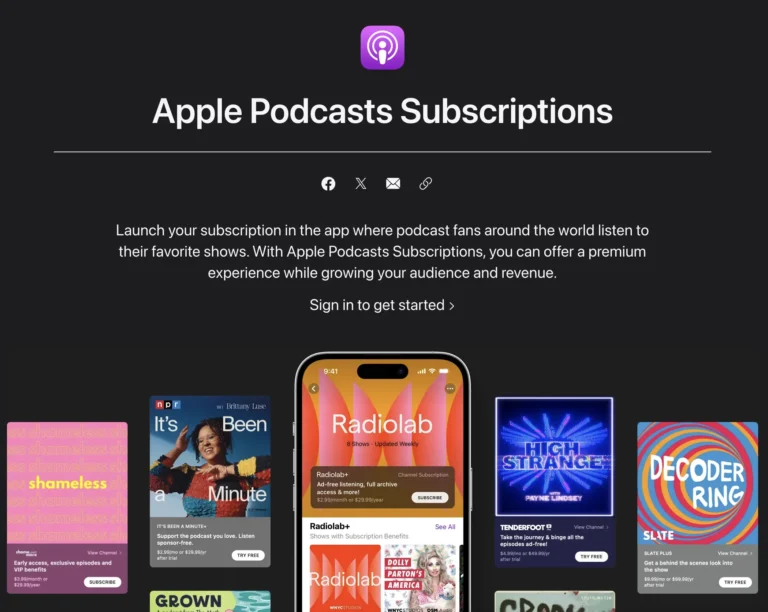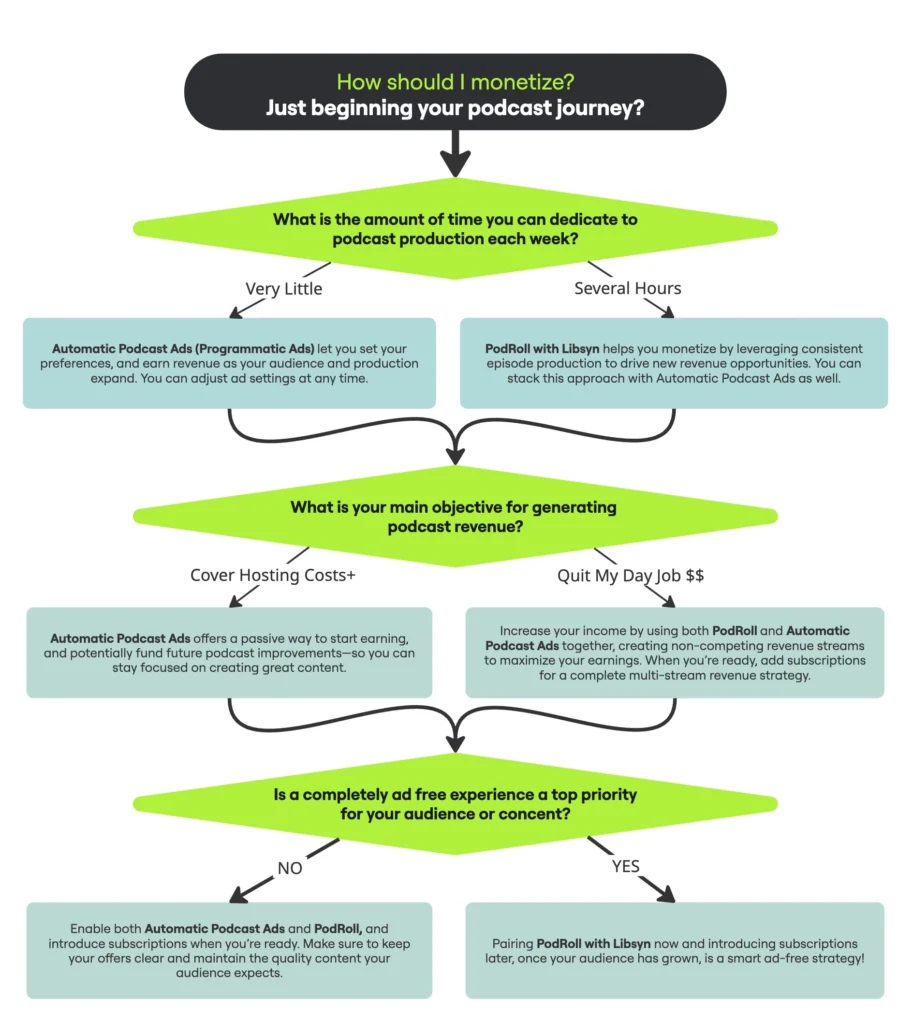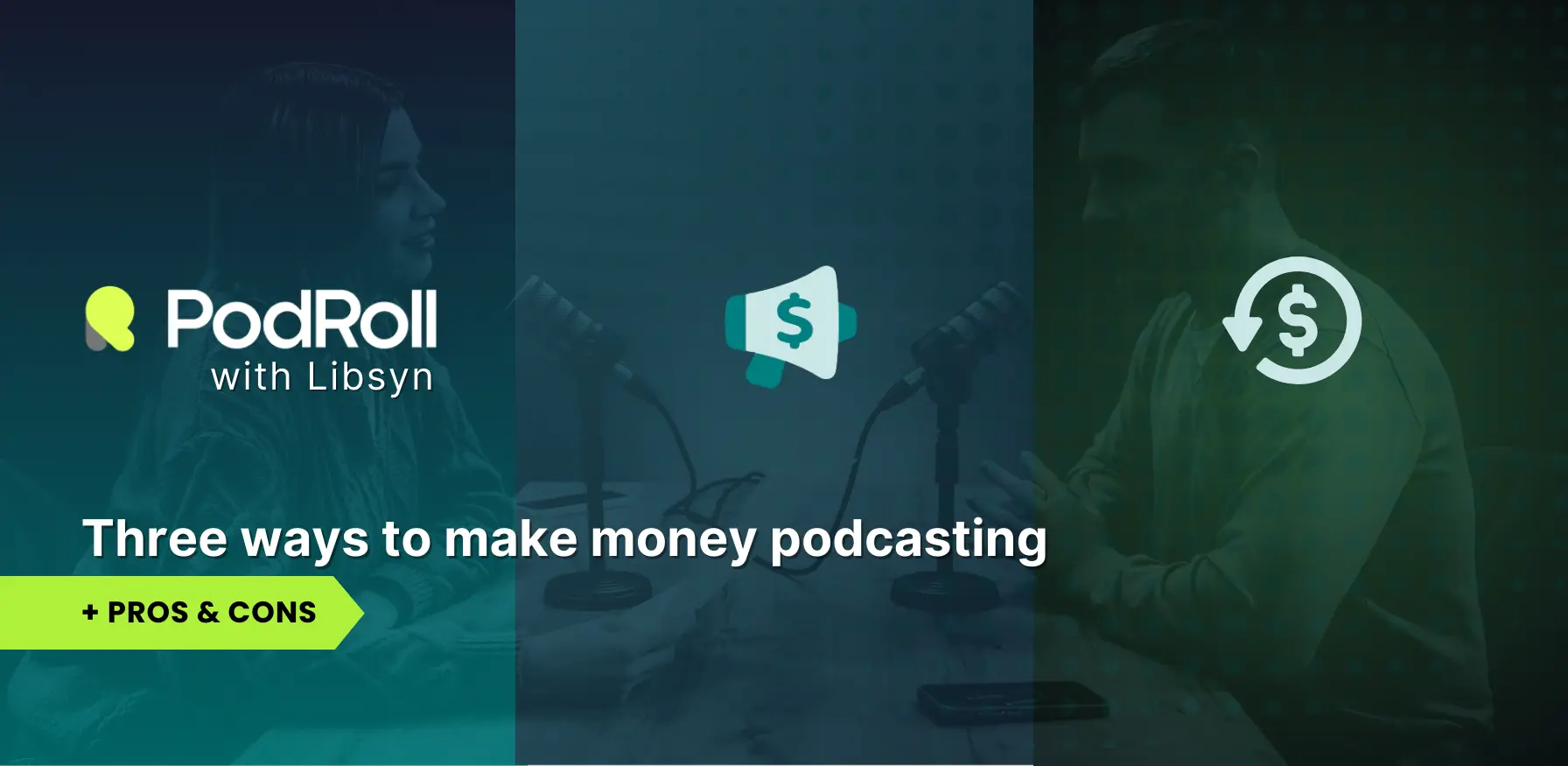You’ve put in the hours: recording, editing, and showing up week after week. You’ve built a podcast you’re proud of, and now you’re asking the big question – how do podcasts make money?
Most advice out there seems aimed at shows with massive followings and major media coverage. Does it feel like everyone’s just talking about securing multi-million dollar “big sponsor deals”? You know, the kind that requires thousands of downloads and being covered in Variety and the Hollywood Reporter? Most podcasters aren’t working with a celebrity name or pulling in hundreds of thousands of downloads a month. And that’s okay.
The truth is, there are smarter, more accessible ways to make money podcasting – and you probably already have what you need to get started!
For both seasoned hosts optimizing their income and aspiring creators eager to make their mark, this blog post is your guide. We’ll dive into three overlooked yet effective monetization strategies that move beyond traditional sponsorships and show you practical ways to make money podcasting to truly unlock your show’s earning potential.
Let’s get into how to make money from your podcast with tools and tactics you may not have considered.
-
Skip Ahead: Discover 3 Innovative Ways to Make Money Podcasting
- Dynamic Feed Drops (PodRoll with Libsyn)
- Programmatic Podcast Advertising
- Podcast Subscriptions
- BONUS: ways to optimize monetization strategies

1. Dynamic Feed Drops (PodRoll with Libsyn): Grow & Get Paid
What if you could make money from your podcast while helping other shows grow their audience? What if it didn’t require ANY ads in your content? Yes! You can still leverage your hard work and audience size without inserting ads, selling a subscription, or recording host-read ads. That’s the power of dynamic feed drops, now available through PodRoll with Libsyn.
How It Works: PodRoll with Libsyn gives all podcasters an easy, non-intrusive way to make money by connecting podcasters looking to promote their shows with those willing to feature them. When you enroll, you consent to a promoted episode from another show to be placed in the second most recent episode slot of your listings on Apple Podcasts and Spotify that align with categories you allow.
The promoted episode is similar to a “You might also like” recommendation shown just below your most recent episode. These promoted episodes don’t change your podcast’s RSS feed or permanently affect your episode list. They’re seamlessly integrated and only appear temporarily. When a listener plays one of these suggested episodes for more than a minute, you get paid.
Your earnings and how often these episodes appear depend on your show’s category, your publishing frequency, and current active campaigns within PodRoll. It’s a simple, passive way to make money podcasting. It’s that simple.

Pros of Dynamic Feed Drops:
“Set It and Forget It” Monetization: Just like programmatic ads, dynamic feed drops are a “set it and forget it” method of podcast monetization. Once enabled, promoted episodes from other shows may appear with each newly published episode.
Non-Intrusive Monetization: Promoted episodes appear as separate, suggested content where listening and earning happen completely outside of your own episode, without disrupting your show.
Audience Growth Potential: By featuring relevant shows, you’re not just earning; you’re also introducing your audience to content they might love, strengthening their loyalty to your brand as a curator.
Helps Other Podcasters: You contribute to the podcast ecosystem by helping other shows get discovered, fostering a supportive community. This can be particularly appealing to podcasters who value audience engagement and community.
Stackable Revenue: Dynamic feed drops don’t interfere with other monetization methods. If you’re already taking advantage of Libsyn’s Automatic Podcast Ads offering, you can layer PodRoll with Libsyn on top to create multiple revenue streams. Payouts are made to you once you have hit a combined amount of $20 across all ad monetization channels.
Cons of Dynamic Feed Drops:
Reliance on Listener Action: You only get paid if your dedicated audience clicks and listens to the inserted episode for at least one minute. This means revenue can be less predictable than impressions-based advertising.
Limited Control Over Specific Shows: While you can exclude certain categories, you won’t handpick the exact shows featured. This approach allows Libsyn to group and promote a wider range of podcasts—including smaller or niche podcasts—so more creators have the opportunity to earn.
Requires New Episode Publication: To activate PodRoll with Libsyn, you’ll need to publish a new episode after enrolling. Re-publishing old episodes won’t activate earning potential, but each new episode release opens the door to fresh monetization opportunities.
If you’re a Libsyn customer, you can set up PodRoll with Libsyn today. Watch our video above or check out the support article for step-by-step guidance.
Who is this best for?
Podcasters Who Prefer a Clean Audio Experience: If you want to monetize without interrupting your main episodes with traditional ads, feed drops offer an alternative.
Community-Minded Podcasters: If you enjoy supporting other creators and believe in cross-promotion as a way to grow the podcasting space, this method aligns well with those values.
Podcasters Seeking Diversified Income: This is a great option for both aspiring creators and seasoned hosts looking to add another way to make money without significant effort. However, it’s vital to understand that the financial benefit from PodRoll with Libsyn depends on how many downloads the suggested episodes receive. Therefore, shows with fewer downloads per episode might not see substantial financial returns, making it more beneficial for those with larger or rapidly growing audiences.
Podcasters with a Consistent Publishing Schedule: Since a new episode publication is required to activate PodRoll with Libsyn, it is most effective for shows with a regular release cadence.

2. Automatic Podcast Ads: Set It and Forget It Income
Imagine a way to start monetizing your podcast episodes without the hassle of cold emails, negotiations, or managing complex sponsorship payments and accounting. Sounds pretty good, right? That’s exactly what programmatic ads offer—and at Libsyn, that powerful solution is called Automatic Podcast Ads, providing a solid way to sell ads and generate ad revenue from your podcast content.
The best part? Libsyn allows all creators to enable Automatic Podcast Ads, regardless of audience size.
How It Works: Submit your show to the Automatic Podcast Ads program. As you enroll, you can exclude categories of programmatic podcast ads you think won’t appeal to your audience, connect your PayPal account, and you’re all set. The beauty here is that unlike host-read ads, you don’t have to record any copy yourself. These podcast advertisements are dynamically inserted into your episodes by our advertising network and are never permanent.
You, the podcast host, have control over how many ad slots you make available, such as pre roll ads (before your content), post roll ads (after), and mid roll ads (during your content). Once approved, your episodes will automatically receive X pre-roll ad slots and Y post-roll ad slots. We suggest you also insert some mid-roll ad slots. The more slots you offer, the more opportunities you have to generate revenue. However, a word of caution: don’t overload your show with ads, as this can deter listeners. As an example, for hour-long episodes, we often recommend no more than 2 pre-rolls, 2 post-rolls, and up to 4 mid-rolls, but you can always use fewer.
Want to dive deeper into programmatic advertising? Read more in our article: Automatic Podcast Ads FAQ: 10 Common Questions Answered About Earning with Programmatic Ads
Pros of Programmatic Ads:
Passive Income: It truly is like setting your podcast monetization on autopilot. You submit your show, set your preferences, and you can make money without active management. This is ideal for podcasters who want to focus on high quality content rather than ad sales.
Leverage Your Back Catalog: With just one click, you can activate programmatic ads across years of past podcast episodes, instantly unlocking more podcast revenue from content you’ve already produced. This is a huge advantage for shows with an extensive library regardless of audience size.
No Sales or Negotiation Skills Needed: You don’t need to find advertisers, pitch your show, or negotiate rates. Our advertising network handles all of that, making it accessible even for those new to monetization. This helps you start monetizing your podcast audience seamlessly.
Immediate Start (Once Approved): Once your show is approved, you can implement ads and start making money podcasting.
Cons of Programmatic Ads:
Lower Payouts per Impression: Compared to direct sponsorships or host-read ads, programmatic ads generally offer lower money per listener, as they are sold at scale through an advertising network.
Less Control Over Ad Content: While you can choose ad categories, you have less direct control over the specific advertisers or the content of the programmatic ads that appear in your show.
Audience Experience: While you control the number of ad slots, there’s always a risk that ads could turn off listeners. The best thing to help with this is to inform your audience that making a little money podcasting will help you keep creating the content that they love.
Who is this best for?
For Seasoned Hosts: If you run a larger show with an extensive back catalog, our Automatic Podcast Ads offer a fantastic, passive way to monetize existing content effortlessly. It’s a smart way to supplement income from other monetization methods without consuming your valuable time.
For Any Podcaster Prioritizing Content: If your main focus is producing high quality content and you prefer a hands-off approach to ad monetization, this programmatic solution frees you from the complexities of direct sales, allowing you to concentrate on your craft while still generating income.
For Aspiring Creators: If you’re just starting your podcast or have a smaller but growing audience, programmatic ads are a great way to learn how monetization tools work and get comfortable with the process. It’s a low-effort way to start, but remember that payouts are impacted by download volume, so don’t expect to get rich quick. Even a little ad revenue can help cover essential costs like podcast hosting, making your journey more sustainable.

3. Subscriptions: Deepen Connection, Unlock Bonus Content
The “how do podcasts make money” discussion would not be complete without talking about paid subscriptions. This is where your most loyal audience directly supports your work in exchange for something extra, tapping into a highly engaged audience.
How It Works: Subscriptions allow you to offer your faithful fanbase something more than just your regular free podcast episodes in exchange for a monthly fee. This could be as simple as ad free episodes, early access to new content, or things that are more elaborate, like bonus episodes, Q&As, behind the scenes content, or even direct interaction with you. You can also offer online courses, merchandise sales, your own products or consulting services as part of your paywalled tiers, creating a more advanced membership model that listeners purchase to directly support you and make money. You could even provide access to exclusive live events!
While third-party platforms like Patreon or Buy Me a Coffee and Supercast are popular options, many podcasting platforms, including Libsyn, offer native support for offerings, such as Apple Podcasts Subscriptions. This means you can manage your bonus offerings directly within your podcast dashboard. You can easily schedule episodes to release earlier for paying members, provide premium content audio, and even release ad-free versions – all done through Libsyn. This approach helps you generate revenue directly from your core audience.
Pros of Premium Subscriptions:
Direct Fan Support & Loyalty: Subscriptions foster a deeper, more committed relationship with your audience. Your biggest fans directly invest in your work, creating a highly engaged and loyal audience. This is a hallmark of successful podcasts where the audience engaged deeply with the content.
Predictable Recurring Revenue: Monthly subscriptions provide a more stable and predictable way to make money compared to fluctuating ad revenues. This is highly valued by creators who treat their podcast as a business who prioritize long-term sustainability and want to be among the highest earning podcasts.
Creative Freedom: You have complete control over what you offer your members, allowing you to tailor benefits that truly resonate with your community and differentiate your podcast. This allows for diverse subscriber only content, including additional bonus episodes.
Ad-Free Experience: Offering episodes without any advertisements as a subscription perk is a strong incentive for listeners who prefer an uninterrupted experience, and it’s easily managed through podcast hosting platforms like Libsyn.
Native Platform Integration: For seasoned podcast hosts seeking integrated solutions and aspiring creators desiring simplicity, native membership support (like Apple Podcasts Subscriptions via Libsyn) streamlines management and consolidates revenue, simplifying your premium content.
Cons of Subscriptions:
Requires Value Proposition: You need to consistently provide valuable content or experiences to justify the recurring subscription fee and retain members. This means extra podcast content creation work.
Audience Building is Key: This strategy works best with an already engaged audience willing to pay for extra value. It might be challenging for very new podcasts.
Marketing Effort: You’ll need to actively promote your membership program to your audience and communicate the value of subscribing.
Churn Management: Like any subscription service, there’s a risk of members canceling. You need to continually deliver value to minimize churn.
Who is this best for?
When Your Audience is Highly Engaged and Communicative: Subscriptions thrive when you have a loyal audience that feels truly connected. This isn’t just about how many listeners you have; it’s about the quality of the relationship. If your listeners are actively responding to your calls to action, answering your questions on social media, or even reaching out to you asking for bonus content or more of your show, it’s a strong sign they’re ready to invest in premium content. This indicates you’ve built a captive audience that’s truly engaged.
When You’ve Identified What Your Audience Will Pay For: Before launching premium subscriptions, it’s crucial to understand what unique value your core audience desires. Through active audience engagement and direct conversations, you’ll uncover what exclusive content or perks (like episodes with no ads, early access, bonus episodes, behind the scenes content, or online courses) they would genuinely pay monthly for. This insight ensures your paid content offers irresistible value, turning loyal fans into paying subscribers.
When You Understand Your Production Capacity: Offering premium content means more content creation. Before diving into subscriptions, it’s essential to realistically assess your ability as a producer or your team’s capacity to consistently deliver the promised additional podcast content. Whether it’s extra podcast episodes, live events, consulting services, or new merchandise sales, ensuring you can maintain high quality content without burnout is key to long-term success and a sustainable income. This strategic approach helps you align your efforts with building one of the most successful podcasts.
The world of podcasting is constantly evolving, and so are the ways creators can make money from their passion. By looking beyond the traditional sponsorship model, you open up a wealth of opportunities to generate income, whether through automated systems, strategic partnerships, or direct audience support. With the evolving landscape of podcasting, there are now more choices than ever to make money podcasting, and these monetization strategies are designed to help you find an approach that truly fits your goals and what you want from your show.
Looking to optimize your ad revenue? See how easy it is to add ad slots in the video above.
Bonus: Advanced Optimization Strategies for Automatic Podcast Ads & PodRoll with Libsyn
Simply activating these monetization features is the first step. To truly maximize your revenue, consider these advanced strategies:
To Optimize Automatic Podcast Ads:
Strategically Place Ads in Your Content: Mid-roll ads generally command the highest CPM rates, so review your episodes and place them at natural transition points, using time codes you note during editing. This human touch is vital to avoid placing ads after sensitive or emotional content, which can negatively impact your target audience. Learn how to add and manage your ad slots in this video.
Be Strategic with Your Back Catalog: For podcasts with evergreen content, activating programmatic ads for all past episodes is a great way to turn an archive into a continuous income generator. However, if your content is more time-sensitive (e.g., daily news), it’s often more strategic to focus on placing ads in your most popular episodes or just the latest couple of months of content.
Understand Ad Load by Category: Ad load can vary significantly by podcast genre (aka your podcast’s topic) For example, True Crime often has a higher load than Comedy. Use this insight to determine a comfortable ad balance for your show, remembering that overloading with ads can deter listeners.
To Optimize PodRoll with Libsyn:
Use Category Exclusions Strategically: You know your audience best, so use category exclusions to help ensure that promoted episodes align with your show’s niche. Opt out of categories that clearly don’t fit—but keep in mind that the more you exclude, the smaller the pool of available promotions becomes. Don’t miss out on earning potential by narrowing too soon. You can always fine-tune your category settings later based on what works best for your listeners.
Layer it with Other Income Sources: PodRoll with Libsyn doesn’t interfere with other income streams. You could combine it with Automatic Podcast Ads, and Subscriptions to create multiple passive ways to earn money that are managed through one centralized platform.

Podcasts Make Money in Many Ways - Use This Framework to Find Yours
With so many monetization strategies available for how podcasts make money, it’s natural to ask: which one is right for me? Though there’s no single path for everyone, this simple framework can help you decide
The questions below are the framework – they’re designed to be reused anytime you’re evaluating a new monetization option, whether it’s subscriptions, ads, merch, or something else entirely.
The answers shown here are examples, based on the specific strategies covered in this article. Use them to help you get started, but remember: these questions can be applied to any income stream you’re considering.
If you are just beginning in your podcasting journey:
As an aspiring creator, your focus might be on getting started, building your podcast audience, and covering initial costs. Here are three key questions to ask yourself:
How much time and effort can I realistically commit to making more money right now?
If your answer is “very little”: Programmatic Ads are designed for maximum ease. They require minimal setup and run passively, allowing you to focus on creating your core podcast content and building audience size.
If you have some time for consistent publishing: PodRoll with Libsyn could be an interesting option for incremental earnings, especially if you’re already publishing regularly.
What’s my primary goal for monetizing at this stage?
If it’s simply to cover hosting costs or earn a little extra: Programmatic Ads can provide a foundational ad revenue stream, even with a smaller audience size and an extensive back-catalogue.
How important is it for me to maintain a completely ad-free experience for my listeners?
If an ad-free experience is a top priority (or you want to offer it later as paid subscriptions): You might lean away from Automatic Podcast Ads initially, or consider PodRoll with Libsyn as a less intrusive alternative. Subscriptions could be a long-term goal once you have grown your target audience.
If you are a more seasoned podcaster:
As a seasoned host, you’re likely looking to make more money, diversify your income, and deepen your relationship with your dedicated audience. Consider these three questions:
How many listeners are currently engaged, and are they actively asking for more?
If you have a highly engaged audience that’s vocal and supportive: Subscriptions are a powerful way to leverage that loyalty. They’re already asking for more, so providing exclusive content or episodes for a fee can be a natural next step to make money.
If your audience is engaged with your content but isn’t yet demanding extras: Focus on optimizing for Automatic Podcast Ads and exploring PodRoll with Libsyn to maximize passive ad revenue and make the most of your wider audience.
What kind of additional content or experiences can I realistically offer my audience?
If you have the capacity for extra content: Subscriptions allow you to offer a wide range of premium content that your loyal listeners would value and pay for.
Pre- and post-show banter that doesn’t make it into the public feed.
Show bloopers or behind-the-scenes moments
Extended interviews or conversations that were left on the cutting room floor
A “listener mailbag” – curated Q&A, feedback, or commentary from your audience.
If your production capacity is already stretched: Focus on optimizing your automated monetization methods like Automatic Podcast Ads and PodRoll with Libsyn, which require less ongoing content creation from your end.
Am I looking to diversify my income beyond traditional advertising, and how much control do I want over that revenue stream?
If you want stable, predictable income directly from your fans: Subscriptions provide the most direct audience support and control over your earnings, making you less reliant on advertising network fluctuations. Many of the highest earning podcasts use subscriptions as part of a diversified revenue strategy.
If you’re happy with automated ad revenue and cross-promotion: Continue to optimize your Automatic Podcast Ads and PodRoll with Libsyn strategies to maximize your existing podcast revenue.
Remember, there’s no single “right” answer. Many successful podcasts utilize a combination of these monetization strategies, layering them to build robust and diversified multiple revenue streams. The key is to understand your own podcast’s unique strengths, your target audience’s desires, and your capacity as a creator.
Whether you’re already a Libsyn podcaster eager to optimize your earnings, or you’re ready to start your podcasting journey with a platform with built in tools to help you make money, we’re here to help. Existing Libsyn users, log in to your Libsyn dashboard to activate these strategies.



